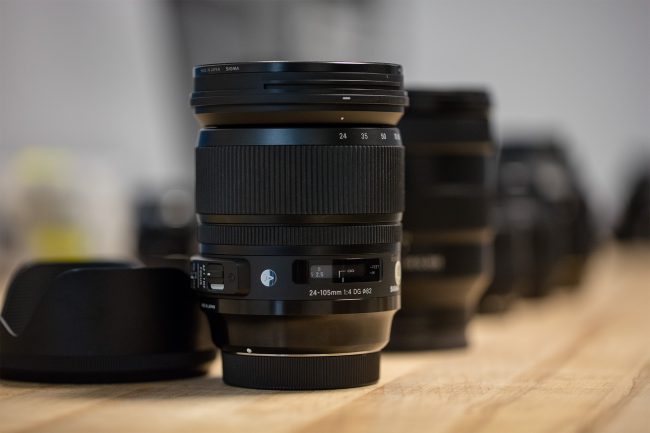Equipment
MTF Testing for the Sigma 24-105mm f/4 DG OS HSM Art Series Lens
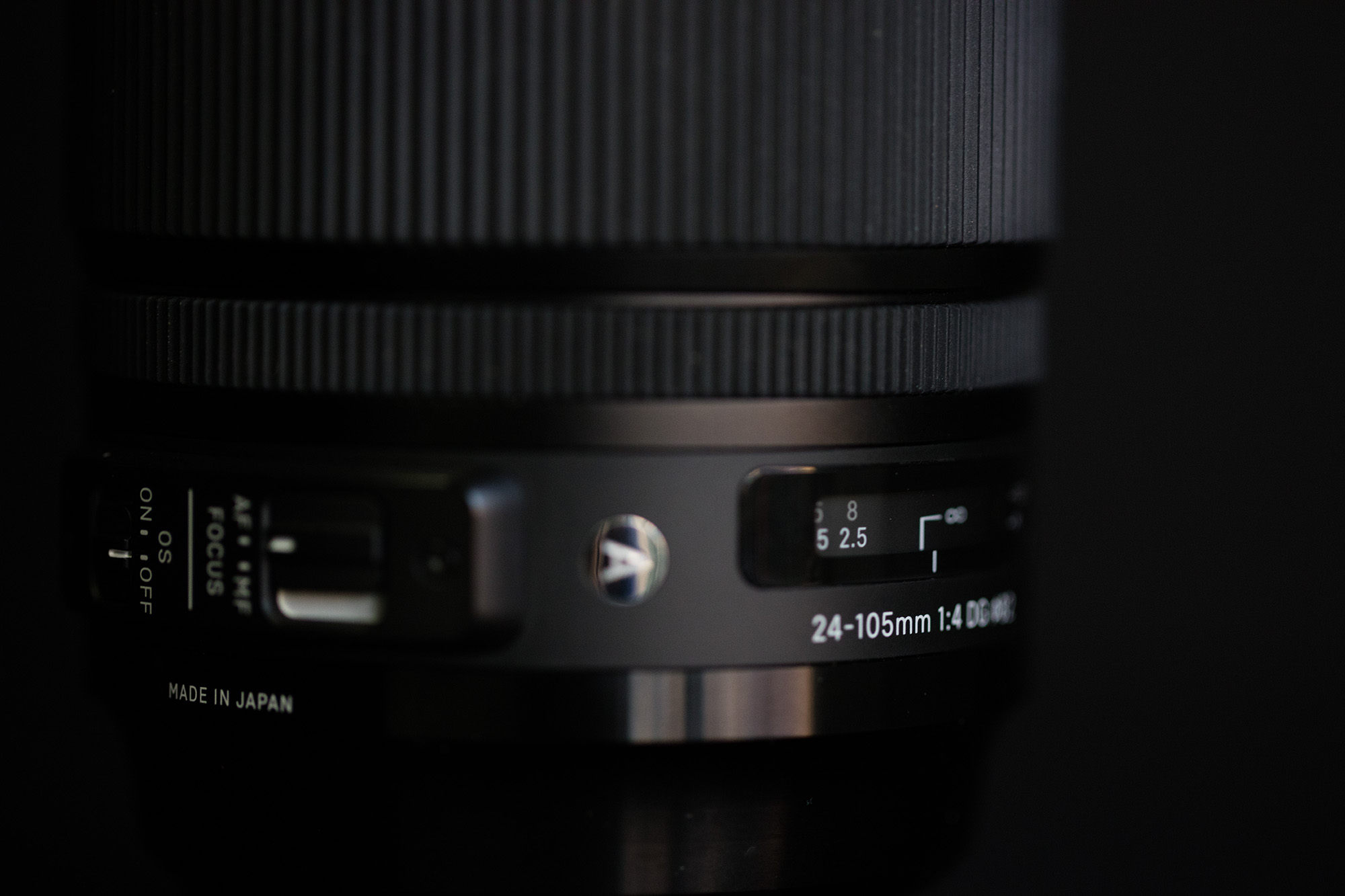
I generally let you know what my expectations are before I start, to hopefully let you know where my personal opinion affects things. The fact that I’m just posting tests of the Sigma 24-105mm f/4 DG OS HSM Art months after the lens was released tells you a lot. I’m not excited about testing 24-105mm lenses; it’s almost always ‘another one like the other ones.’
Don’t get me wrong; these are useful and popular zooms for a reason. I’ve owned several and used them a lot. The focal length makes them superb general purpose and walk-about lenses. But designing a zoom that goes from retrofocus to telephoto is a daunting task. My conclusion for almost every one of them has been “decent from 24mm to 70mm and usable past that if you need to.” I didn’t expect anything different from this lens, Art or not.
But the $899 price tag is attractive, compared to $1099 for the Canon 24-105mm IS II or Nikon 24-120mm f/4 ED VR. The weight of 855 grams (31.2 oz) makes it just slightly heavier than the Canon (795 g) and Nikon (710 g), so the weight penalty isn’t severe like it is with some Art lenses. So my expectation was definitely ‘another one like the other ones’ would be a success, given the lower price tag on the Sigma lens.
Optical Tests
MTF
If you don’t know that MTF stands for Modulation Transfer Function (1, 2, 3, 4), then just look at the pretty graphs and remember higher is better, the left side of the graph is the center of the image, and the right side is the edge.
At 24mm
This is really amazing center sharpness for a zoom. It does decrease away from the center but so does every 5X zoom. This is really exceptional performance.
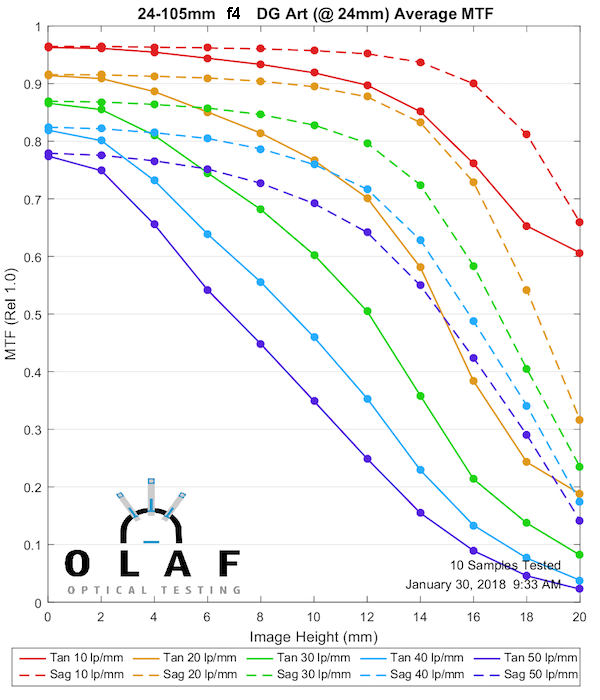
Olaf Optical Testing, 2018
At 70mm
The center at 70mm isn’t quite as great, although that’s partly because the center at 24mm was so amazing. This is a really good MTF curve, though, and performance away from center is better than at 24mm.
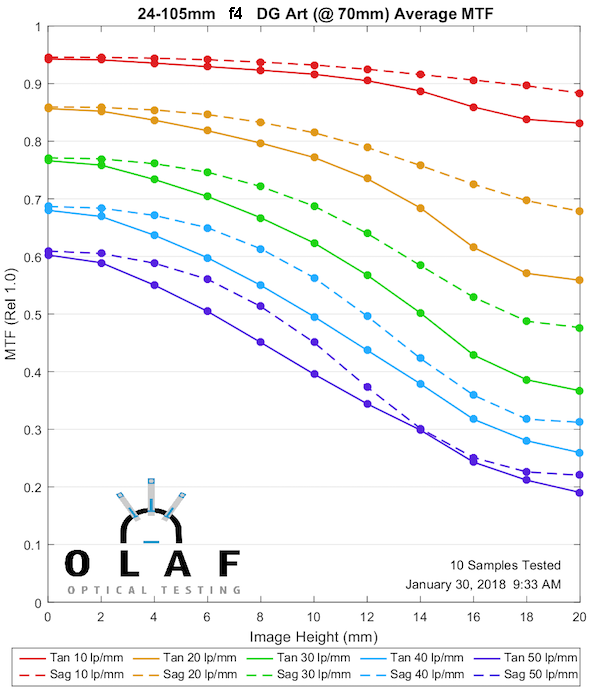
Olaf Optical Testing, 2018
At 105mm
And here’s a bit of ‘another like every other.’ Performance at 105mm isn’t as good as at the shorter focal lengths, although this is still pretty good as comparisons will show later on.
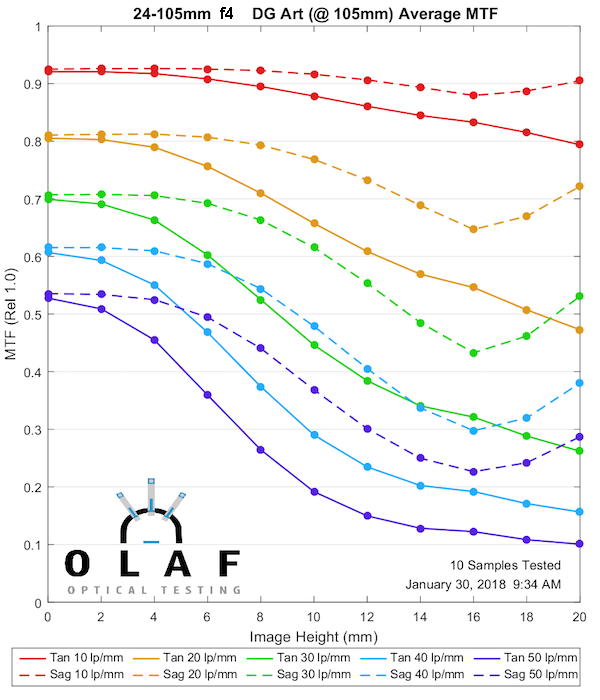
Olaf Optical Testing, 2018
Sample Variation
Zooms tend to have a lot of variation, and 5X zooms more than 3X zooms, but f/4 helps keep that under control here. This is actually quite a good performance as far as sample variation goes, particularly at 24mm. This is similar to the degree of variation seen on Canon 24-105 f.4 IS II lenses, which we consider a nice, consistent lenses with limited sample variation.
24mm
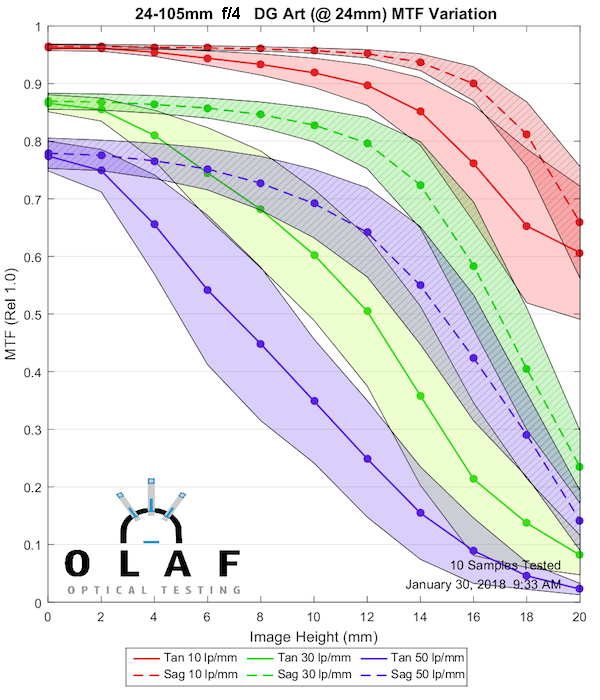
70mm
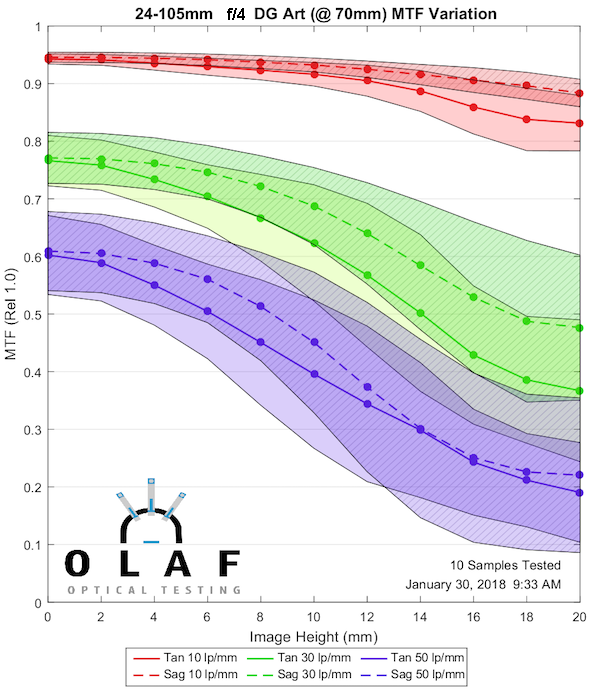
Olaf Optical Testing, 2018
105mm
There is more variation at 105mm, but that is the nature of the beast. Every 24-100+ zoom has more variation at the long end.
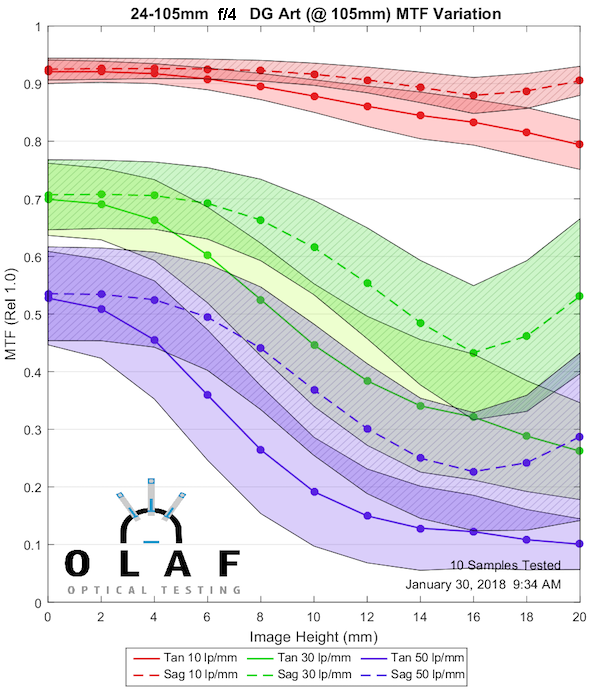
Olaf Optical Testing, 2018
MTF Comparisons
The logical comparisons (that I thought of) are to the Canon 24-105 f/4 IS II and the Nikon 24-120 f/4 VR lenses. I’m sure someone is going to ask me to compare it to the Leica 21mm f/1.4 or something, but this made more sense to me.
Sigma 24-105mm f4 OS Art vs. Canon 24-105mm f.4L IS II
24mm
The Sigma’s performance in the center of the image is just amazing for a 5X zoom, and it remains better at least halfway to the edge of the image. In the outer 1/3 of the image, there’s not much difference. But the difference in the center of images at 24mm should be noticed fairly easily.
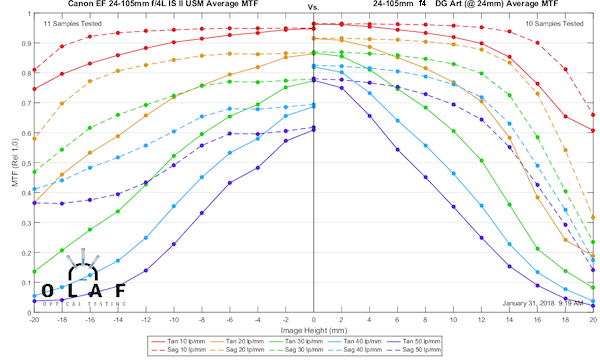
Olaf Optical Testing, 2018
70mm
The Sigma 24-105mm f/4 OS Art is still superior to the Canon 24-105mm f/4 II at 70mm, although things are closer. The Sigma also has less astigmatism-like separation between sagittal and tangential resolution, and that remains so all the way to the edge of the image. Generally, that results in a smoother look and better bokeh. (Yes, I realize not many are buying f/4 zooms for bokeh, but it’s worth mentioning.)
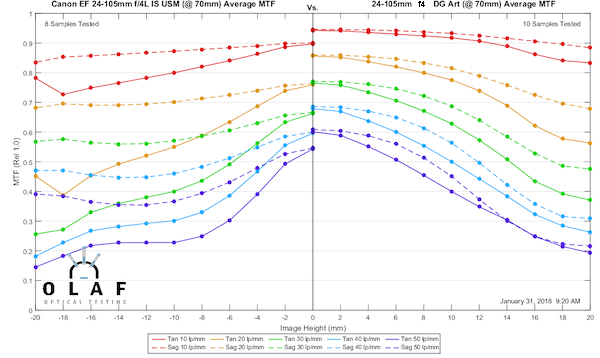
Olaf Optical Testing, 2018
105mm
The party is over at 105mm for the Sigma, and there’s virtually no difference between the two lenses at this focal length. Neither is as sharp as at shorter focal lengths, but both are still very usable.
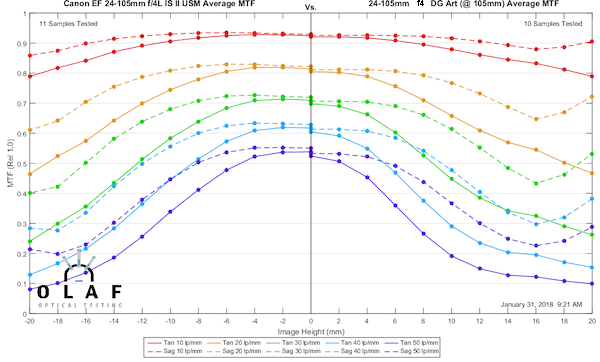
Olaf Optical Testing, 2018
So what would you notice in photographs? I’m pretty comfortable you could tell the Sigma is better in the center at 24mm. I think you’d probably find the Sigma very slightly better at 70mm, but you might have to pixel peep a bit to do so. At 105mm any differences you see are just copy variation.
Sigma 24-105mm f4 OS Art vs Nikon 24-120mm VR
This shouldn’t be a fair comparison; the Nikon has a longer zoom range and is a much older design. But it has maintained a good reputation as an excellent walk-around and general purpose lens, and since the Sigma is available in F mount, I thought we should look.
24mm
Things are actually more even between the Sigma and the Nikon. The Sigma has better MTF at higher frequencies (fine detail) in the center and maintains a little better MTF away from the center. The Nikon, though, has less astigmatism-like separation.
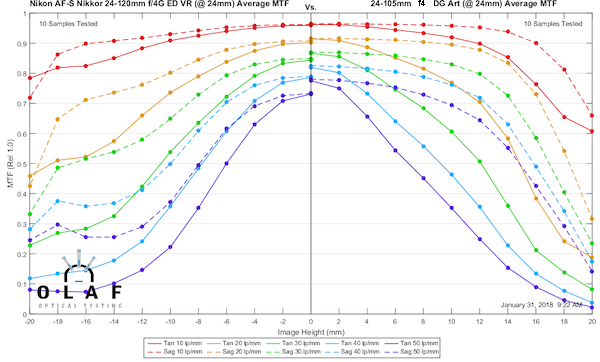
Olaf Optical Testing, 2018
70mm
The Nikon is actually a bit better at 70mm in the center at higher frequencies, with things being very similar away from the center.
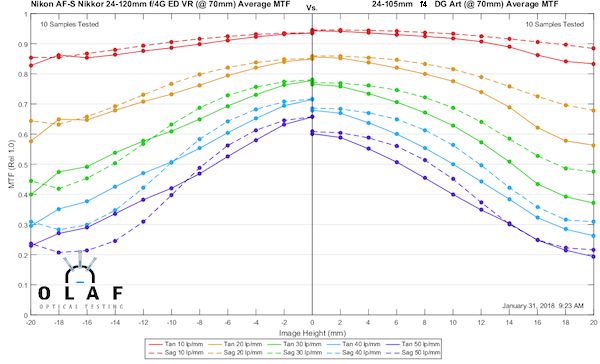
Olaf Optical Testing, 2018
105mm vs. 120mm
The Sigma doesn’t reach 120mm, and I don’t have data for the Nikon at 105mm, so this is the only long-end comparison I can do. Again, the Nikon at 120mm is performing at least as well as the Sigma at 105mm, which is most impressive.
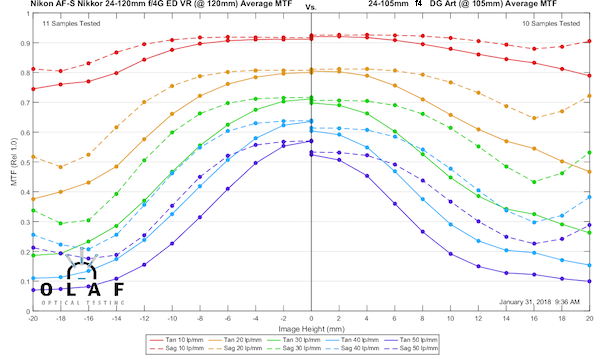
Olaf Optical Testing, 2018
Would you see these Nikon-Sigma MTF differences in a photograph? I don’t think so. Sample variation is about as large as the difference between averages; so a given copy of the Nikon may be a little better, a little worse, or exactly the same as the Sigma. I would not choose between these two lenses on the basis of sharpness. There are other, more important, factors to consider.
Stopping Down
NOTE: Sorry to take so long getting these repeated. I took a couple of days vacation and wanted to do these myself and make sure I got them correct. We found the reason first set of graphs was incorrect: the machine had been set to test a different size lens, human error didn’t catch it, and the software didn’t have a built-in check, so it mapped the center 1/2 of the image out as though it was the entire field. The machine has been corrected, the software is being corrected, but the humans, until we can replace them with AI, remain human. We’ll make mistakes. The ultimate mistake is mine – I was more enthusiastic about something else I was doing and didn’t supervise this as closely as I should have. My thanks to those who made comments and pointed out the error.
In correct stop downs, we do still see dramatic improvement at f/5.6 in the 70mm images, a noticeable improvement at 105mm, but only a slight improvement at 24mm.
24mm
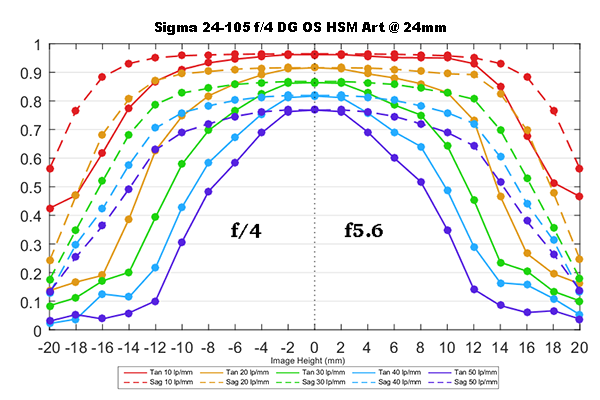
Olaf Optical Testing, 2018
70mm
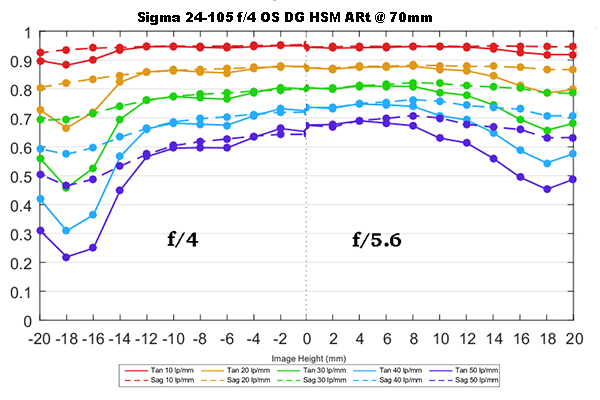
Olaf Optical Testing, 2018
105mm
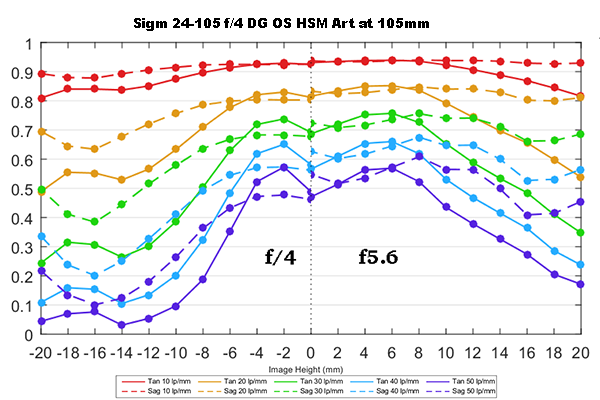
Olaf Optical Testing, 2018
Field Curvature
The field of focus curvature gives us a lot of information. When the MTF graph falls off at the edges, we don’t know how much is because the resolution is decreasing and how much is because the field of best focus is moving to another plane.
These are quad graphs: the upper left shows the ‘average’ field (the sagittal and tangential values are averaged). Lower left and right graphs separate the sagittal and tangential fields (which lets you visualize astigmatism to some degree – where the fields don’t overlap there is astigmatism). At the upper right is a difference graph showing you that astigmatism. Remember the plane of center focus is a horizontal line through the middle of each graph. Astigmatism behaves differently in front of, and behind, the plane of best center focus.
Again, this is a single lens, so you’ll notice a bit of tilt in the field. That’s because it’s a zoom and they all have a bit of tilt in the field. Unless it’s dramatic in this test (and none of these are), it’s not noticeable in actual photography.
24mm
At 24mm the field is really nice and flat, with just a little bit of curve at the very edges. (Geek MTF lesson – notice how the tangential graph doesn’t stay as sharp (yellow and orange) as the sagittal lines towards the edge of the image? You saw that in the MTF graph at 24mm, too.)
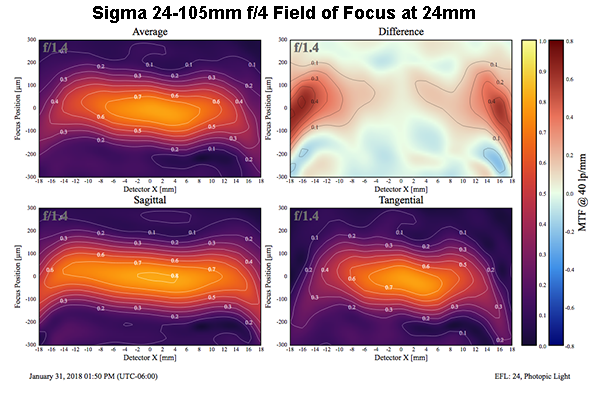
Olaf Optical Testing, 2018
70mm
At 70mm we begin to see a little U shaped curve in the field of focus. It’s not very strong, but you could probably notice it in a photograph. (My favorite real-world technique is to focus on a rock in the center of a mowed yard, then run a ‘find edges’ or similar filter on the image. You’ll see the field curvature.
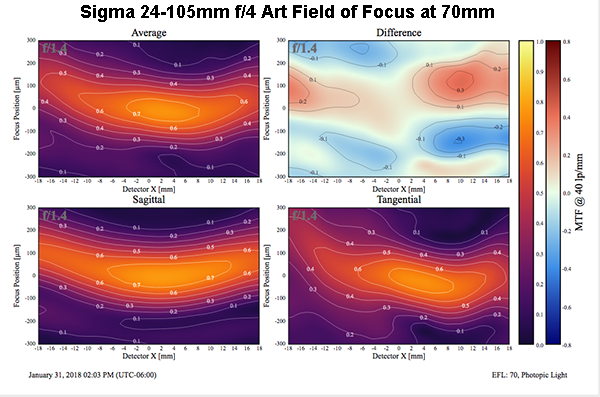
Olaf Optical Testing, 2018
105mm
The sagittal cure maintains its slight U shape at 105, but the tangential field changes to a, well, I don’t know. Blob maybe?
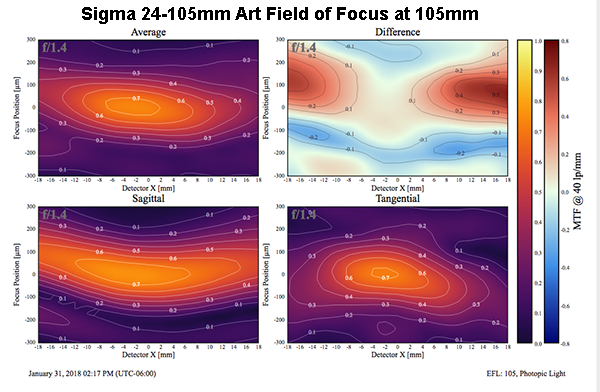
Olaf Optical Testing, 2018
So What Did We Learn Today?
Well, my true confession is that I view 24-105mm f/4 lenses as sort of the Minivan of camera lenses; practical, useful, and totally not sexy. I’ll admit I use them a lot, but having one mounted on my camera makes me want a bumper sticker on my bag that says “My Other Lens is a Ferrari” or something.
I’ll also admit it has been a long-term policy of mine to never like any 24-105mm f/4 lens. My highest praise for a 24-105mm to date has been ‘doesn’t suck as much as I expected’. I’ve never veered from that policy while reviewing lens after lens after lens*. It has become a tradition.
I value tradition, so I’m going to make my summary ‘This is the Best Damned 24-105mm f5.6 Lens Ever Made’. Because did you see how amazingly good this thing is stopped down to f5.6 at 70mm? That is a remarkable thing for any zoom lens, and even more remarkable for a zoom that ranges from wide-angle to telephoto. Honestly, if you are shooting at f/5.6 I can’t imagine any lens at any price doing significantly better than this.
Even at f/4, the Sigma 24-105mm f/4 OS Art is still pretty amazing at 24mm. That center sharpness really shocked me. I wasn’t expecting that. Otherwise, this is a 24-105mm f/4 image stabilized lens that as good or better optically as any of the others I’ve tested and available at a lower price.
There are always other things that are more important when deciding if this is the lens for you, of course, but you can be very comfortable about the resolution being excellent and the sample variation is small. I’d call it clearly better, from a resolution standpoint, than the Canon 24-105 f/4 IS II. The Nikon 24-120 f/4 VR, though, is aging very gracefully and certainly holds it’s own at f/4.
And yes, I realize I’ve just said ‘this is the hottest Minivan on the market’ but hey, if you need a minivan, you might as well get the hottest minivan. Maybe paint some flames on the side, too.
Roger Cicala and Aaron Closz
Lensrentals.com
February, 2018
* The official lens reviewer terminology is if you’ve tried it once you say “in my experience”. If you’ve tried it twice, you say “in my series of tests”. If you’ve tried it three times, you say, “I’ve seen this in lens after lens after lens.”
Author: Roger Cicala
I’m Roger and I am the founder of Lensrentals.com. Hailed as one of the optic nerds here, I enjoy shooting collimated light through 30X microscope objectives in my spare time. When I do take real pictures I like using something different: a Medium format, or Pentax K1, or a Sony RX1R.
-
Eta76
-
Mustafa Rony Zeno
-
Justin
-
Miroslav Kví?ala
-
Dana
-
Nemo Niemann
-
Mark Rustad
-
Tom
-
Jaanish Fotografie
-
Roger Cicala
-
Roger Cicala
-
SolJuJo
-
Roger Cicala
-
SolJuJo
-
dyna
-
Zach Sutton Photography
-
Matt
-
Andrej Belic
-
Chik Sum
-
Tom Burke
-
cb5107
-
Adam Brown
-
Oleg
-
Adam Brown
-
Oleg
-
Nobody Knows
-
Nobody Knows
